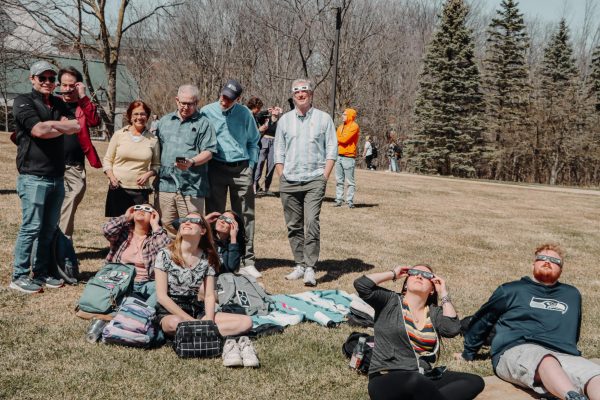Professors cancel classes, students swarm the Cook Carillon Tower and scatter the lawns in front of Zumberge Pond. The balconies of Lake Superior Hall and the Russel H. Kirkhof Center fill with people with their eyes turned to the sky. Grand Valley State University staff, students and community members rush outside as the time approaches 3 p.m. on Monday, April 8 to witness an astronomical phenomenon that won’t be seen again in the United States for the next 20 years.

The occasion drawing so much attention was a total eclipse, an astronomical event casting a shadow that left some parts of the United States in a strange dimness and others enveloped in darkness resembling nighttime. Many made a point to witness the eclipse, traveling to other locations or gathering for the on-campus celebration led by the Department of Physics.
A total eclipse is when the Moon crosses the face of the Sun, as seen from the Earth. The shadow of the Moon is only about 100 miles wide on Earth, which makes it more rare to witness because the shadow won’t cover as much ground, according to GVSU professor of astronomy Douglas Furton.
“I can’t say why the eclipse captured the attention of so many people on campus and around the country, except to note that solar eclipses are pretty rare (total eclipses are very rare) at a given place on Earth,” Furton said. “Although there are a few or so each year, only people in the right place at the right time experience a solar eclipse when it happens.”
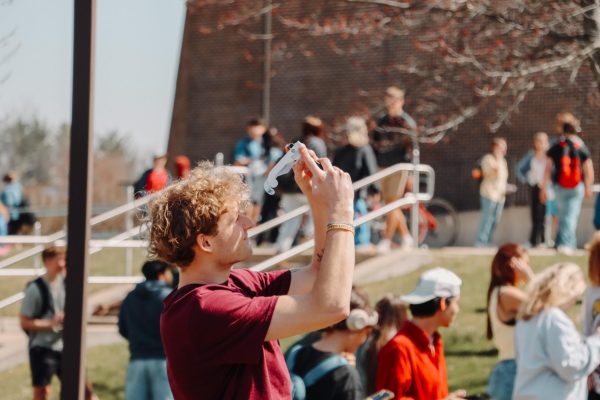
This is often confused with a lunar eclipse, which is when the Moon moves through the Earth’s shadow. This event is much more frequent and visible due to the larger shadow which covers more ground area.
Astronomy professor Geoff Lenters said the uniqueness of this event occurring naturally is one of the most curious aspects of the total eclipse. According to Lenters, the Moon’s orbit “didn’t have to be just the right size” to barely block out the Sun.
“It is quite amazing that the Sun, for which you could fit about 440 Moons across the diameter, can be completely blocked by the Moon simply because the Moon is about 440 times closer to us
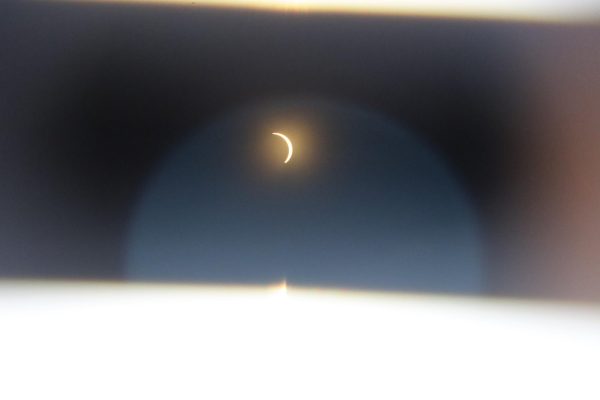
than the Sun,” Lenters said. “People who view the eclipse for the first time get to experience that surreal lighting that occurs during an eclipse, and, for those experiencing a total eclipse, the view of stars and planets in the daytime sky as well as the behavior of the flora and fauna around them during the period of darkness.”
The Department of Physics passed out eclipse-strength glasses to students for free prior to their viewing event. If students were not able to acquire the correct protective glasses, the Physics program also set up solar telescopes and a pinhole camera.
The partial eclipse began at 1:55 p.m. and ended at 4:24 p.m with the amount of Moon coverage in Grand Rapids reaching about 93% coverage at its max point.
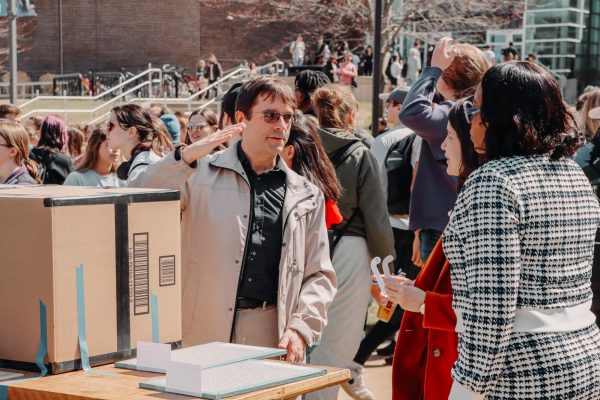
The physics students and department faculty, administrators and other GVSU community members counted down until the moment of maximum coverage.
At exactly 3:11 p.m, everyone gathered across the lawns let out a cheer in celebration, passing solar protective glasses around and chattering excitedly.
GVSU student Abby Lewin said there were numerous people outside with their eyes, covered with protective glasses, directed toward the eclipse. She, like many other students on campus, had her class meeting delayed so students and faculty could witness the rare event.
“I was really surprised that a lot of people were out here,” Lewin said. “I was planning on not skipping my class, but going in late, and then my teacher said, ‘Oh, we’re not gonna’ go into class today until 3:30 p.m. to watch (the eclipse),’ and I was surprised everyone else did that too.”
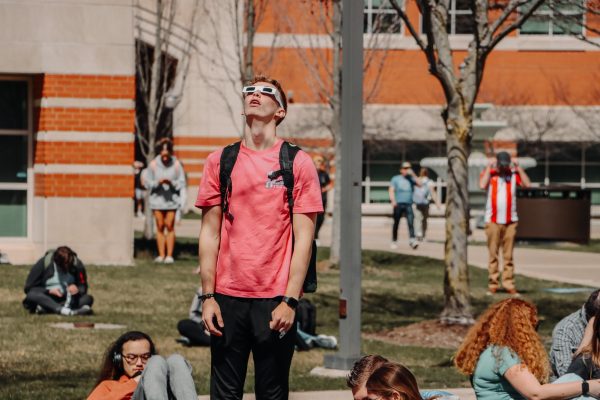
GVSU student Chloe Schram celebrated her 21st birthday during the eclipse. She said she took the astronomical coincidence as a cosmic sign of good luck.
“I’m unsure of what it really means to have a birthday on an eclipse day. But it seems exciting,” Schram said. “I feel eager for the year to come. I’m gonna take it as a good omen that my birthday is on eclipse day.”
GVSU student Clare Meteer said it was really unique to see so many students together celebrating the same moment.
“This is really cool,” Meteer said. “I just really like the communal aspect of it, like it’s so cool to see so many people gathering in one place, and I think it’s a great feeling.”
Student Janelle Weiberg said experiencing the eclipse felt like something out of a TV show.
“(The eclipse) reminds me of the episode in The Vampire Diaries when there’s an eclipse, like when they’re in the prison world,” Weiberg said.
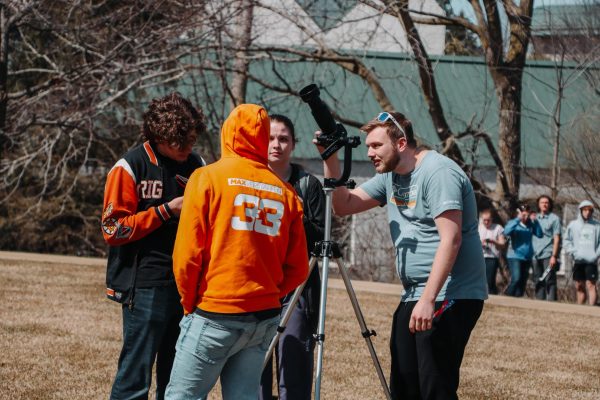
Lenters watched the eclipse from home, experimenting with photography using a telescope. He reminisced on his previous experience seeing a total eclipse a few years ago in Illinois.
“I already had a view of a total solar eclipse in 2017 from Carbondale, Illinois. It was quite an
experience– I cannot even find the words to describe the hot pink color of the hydrogen emission in the solar prominences and filaments against the dark background of the sky, the Moon’s shadow, and the white of the solar corona,” Lenters said. “It is breathtakingly beautiful and something that cannot be seen by the naked eye except during a total solar eclipse. Even though we didn’t experience totality, the lighting was like something out of a movie.”
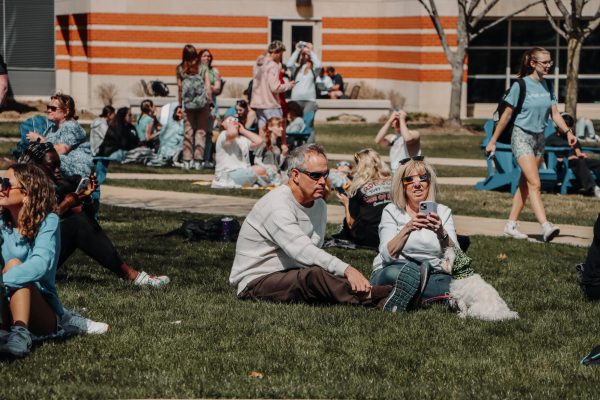
The nearest point of totality, or the point of which the Moon most fully covers the Sun, was closest to Ohio. Furton said to celebrate the eclipse, he took advantage of the nice weather and flew across state lines to be within range.
“I flew a small airplane to the Neil Armstrong airport near Wapakoneta, Ohio, and saw the total eclipse from there, and skipped over the traffic to get home. It was beautiful,” Furton said.
Some felt they experienced a selection of symptoms due to the eclipse taking place, including a dry throat, chills, lightheadedness or a headache. Many call it “eclipse sickness.”
Furton and Lenters agreed there is no scientific significance to these claims, though Lenters said someone could potentially experience chills due sunlight being blocked by the Moon, which indicates the Sun as the “primary driver” of Earth’s climate.
“I would argue that these symptoms are entirely a psychological effect rather than a physical
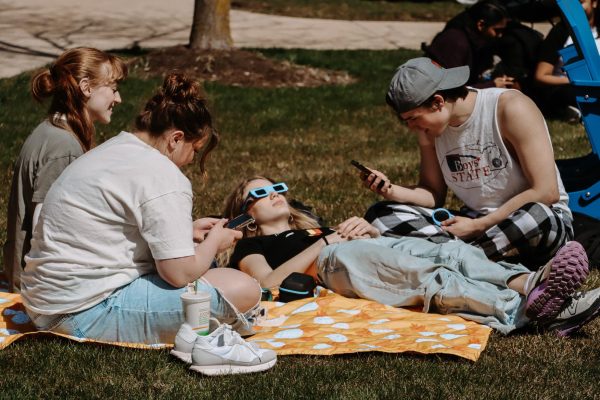
effect,” Lenters said. “Most of the other things that climate alarmist focus upon are really tiny effects in an extremely complex, yet extraordinarily resilient and robust life-sustaining system — probably not something to worry about and certainly not something to be used to form public policy.”
Whether students prepared or traveled for the total eclipse, the experience gave many students a new story to tell.
GVSU student Julian McKenzie said it has, coincidentally, become tradition for him to be at GVSU for an eclipse. He predicts at the next eclipse in 20 years, he will probably somehow still be at the University.
“I think I’ll be at Grand Valley (when the next eclipse comes) because the last time there was an eclipse, I was here. Like, I was not a student, I was moving my sister (a GV alumni) in,” McKenzie said. “And then the next time, I’m here graduating. So, the next time, who knows who I’m going to be moving in here? Maybe I’ll be a professor here.”
